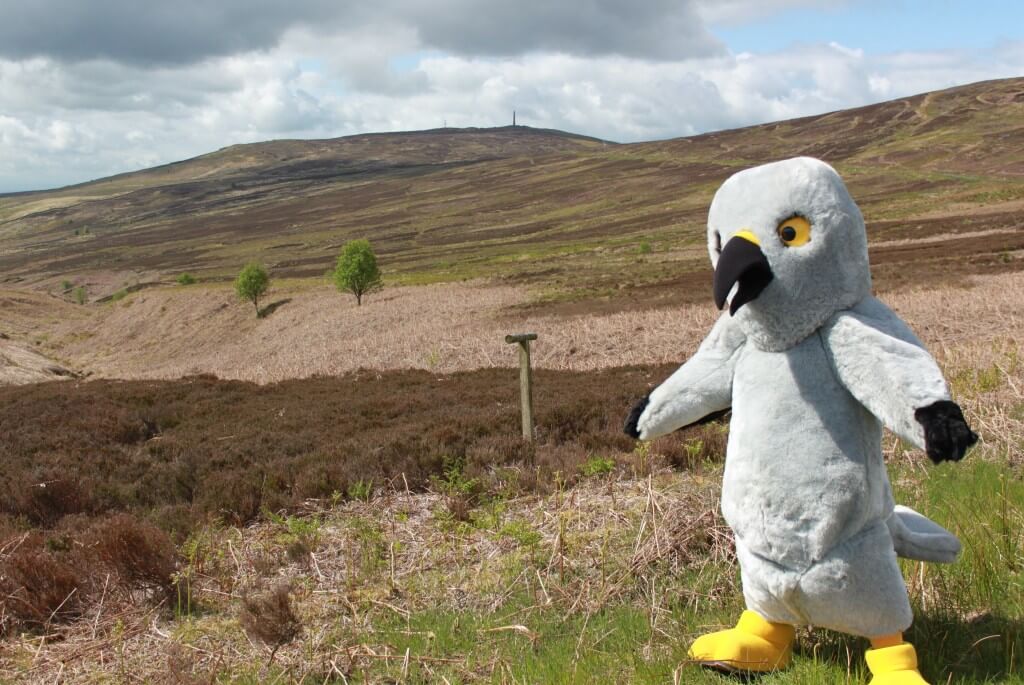You see? I said Henry was with me at Langholm. There’s Sir John’s monument again atop the hill.
In the foreground there is not only a six foot Hen Harrier (isn’t he lovely? don’t you just want to give him a cuddle?) but also a couple of bits of wood nailed together in the shape of a T. That’s a place to put out food for Hen Harriers so that they don’t eat ‘too many’ Red Grouse – that’s Red Grouse that people want to shoot for fun a few weeks later.
Diversionary feeding was tried, very successfully at Langholm after the end of the Langholm 1 (we’ll get to Langholm 2 on Thursday). Diversionary feeding reduced the number of Red Grouse chicks brought to Hen Harrier nests by up to 80%. That’s pretty impressive isn’t it (or pretty blooming obvious depending on which way you want to look at it!). What this showed was that Hen Harriers, like Henry, would choose the easy life and take food provided for them if it was on offer – and it was. So this might look like a solution to the harrier/grouse shooting conflict but it wan’t quite that simple.
Grouse numbers at the end of the season weren’t really any higher. How puzzling.
The Hen Harriers might have been playing silly buffers and eating the grouse just for fun but not bringing them back to the nest or else there was something else killing off Red Grouse chicks in a big way. If the latter, this might let Hen Harriers off the hook a bit.
Diversionary feeding looked promising but the shooting community have never seemed keen on it. First, because the Langholm diversionary feeding trials were promising but not conclusive. Second, because, I think, the grouse industry were worried about where all those well-fed Hen Harrier fledglings might end up – they’d be back the next year causing more trouble. And third because the prospect of telling their gamekeepers to stop being beastly to Hen Harriers and cosset them through the breeding season, feeding them near the nest each day, wasn’t something that many moorland owners fancied doing.
So we don’t see many moorlands tolerating more Hen Harriers because they know that they can limit their impacts through diversionary feeding. Do we see any?
In the interview I did with Prof Ian Newton FRS in the soon-to-be-published Behind the Binoculars we talked about Langholm and about diversionary feeding. Ian said ‘Feeding Hen Harrier broods seems to work – it reduces the numbers of young Red Grouse that harriers kill, but I can’t imagine that method being taken up on a national scale by gamekeepers.‘ (p141). Nor can I, Ian, nor can I.
[registration_form]

i’m bone idle and can’t find or be bothered to find the detailed research so please Mark, could you explain the ‘up to 80%’?
5% is within the ‘up to’ but I’m guessing that wouldn’t be classed as pretty impressive.
Thanks.
Oh alright then, I’ll find out myself –
“For both years combined, fed harriers delivered on average 0•5 grouse chicks to their nests per 100 hours, compared with 3•7 grouse chicks delivered to nests without supplementary food.”
Which I think can be translated as “there was a reduction on average of 86.5% in the grouse chick take in nests provided with diversionary food.” I’ve taken the liberty of changing the wording to diversionary food as this better describes what is being done.
I just don’t like the “up to” qualifier – it is snake oil language and seen in disingenuous sales and marketing “up to 50% off, offers” when almost all items bar one has a reduction of much less!
Pedantry over.
This link to the Langholm site provides a good summary on the effect of diversionary feeding – http://www.langholmproject.com/diversionaryfeeding.html but as Mark says the number of grouse did not increase which Langholm put down to overwinter mortality.
The 7 year Langholm review concluded that 82% of dead adult tagged grouse recovered (874) showed signs of predation by unspecified birds of prey. But this was estimated to represent only 10% of overall grouse mortality. If we extrapolate assumed bird of prey predation to total mortality, it means Langholm’s birds of prey have taken an average of 3 adult grouse a day, every day for 7 years. Not impossible, but what evidence there is suggests that adult grouse form only a small part of the diet of Langholm’s birds of prey and of these, little evidence that hen harriers take adult grouse.Bearing in mind small numbers of hen harriers and even tinier populations of other birds of prey such as goshawk and peregrine (which certainly do feature adult grouse in their diet) in the Langholm vicinity, the review’s conclusions about the impact of predation must be called into question. Even more so when the review is quiet about how it identifies raptor kills, any analysis of how many “raptor killed” grouse would have died anyway through disease, bad weather or lack of food and what proportion of kills may actually be scavenged prey.